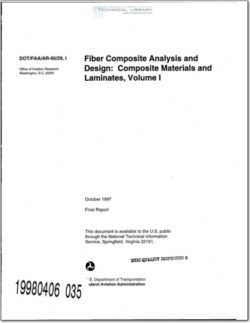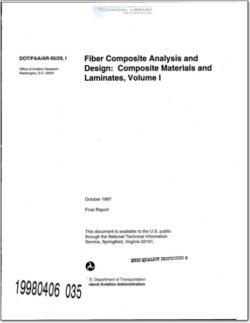DOT-FAA-AR-95-29

- Version
- 590 Downloads
- 13.90 MB File Size
- 1 File Count
- March 23, 2016 Create Date
- March 23, 2016 Last Updated
Fiber Composite Analysis and Design; Composite Materials and Laminates, Volume I

This document, originally published as FAA technical report DOT/FAA/CT-85/6, Fiber
Composite Analysis and Design, Vol. 1, Composite Materials and Laminates, provides an
extensive background on the characteristics and mechanics of fiber reinforced composites which
permits engineers experienced in the evaluation of structures involving conventional
materials—especially metals—to extend their competence to the assessment of fibrous composite
structures. The emphasis is on the definition of the nature and magnitude of the differences
associated with the use of composites rather than conventional materials and especially toward
the elucidation of the reasons for the differences and their implications for design evaluation. .
Accordingly, a broad spectrum of technologies is involved, ranging from detailed methods of
analysis to more qualitative discussions on methods of analysis and design. The material is
divided into two major categories: (1) composite materials and laminates, treated in this volume
and (2) structures, presented as volume 11 in a separate FAA technical report (DOT/FAA/CT—
88/ 18, Fiber Composite Analysis Design Vol. II, Structures), which is currently undergoing
similar revision and should be available early in 1998. The present volume has been revised to
include significant advancements in the state of the art as well as the mechanics of composites.
The present volume is a revision of the original 1988 report, with significant changes in sections
3.2.6 and 4.8 dealing with fatigue. In addition, since many new fibers and matrix materials
have been developed since the release of the original report while others are no longer in
production, section 2.1 of the previous release has been expanded here to a full chapter
(chapter 2) to provide a broader coverage of the constituents. Accordingly, chapter 3 of the
present volume includes material previously identified as sections 2.2 and 2.3, while the present
chapter 4 on laminates is the material previously identified as chapter 3. Various other sections
have been revised for clarity and improvements in accuracy.
Chapter 1 of this volume gives an overview of the subject dealing with the characteristics of
composite materials, their potential for structural applications, the reasons for their use, and
general principles for their utilization. A detailed technical review of available constituent
materials and their properties is given in chapter 2. The subject of unidirectional composites,
which consists of aligned continuous fibers embedded in a matrix material, is addressed in
chapter 3. The principles of micromechanics, which provides a basis for relating the stiffnesses,
strengths, and other properties of the composite to those of its constituents are discussed in some
detail. The reasons for the highly anisotropic character of fiber composites are explained.
| File | Action |
|---|---|
| DOT-FAA-AR-95-29 Fiber Composite Analysis and Design; Composite Materials and Laminates, Volume I.pdf | Download |

Comment On This Post